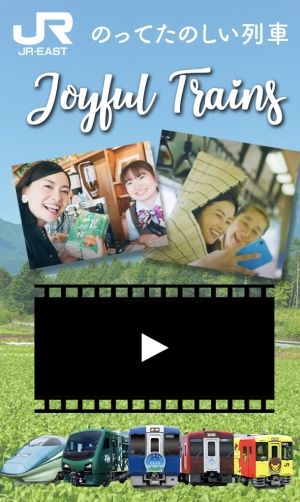Travel back in time: Alleys of Tohoku
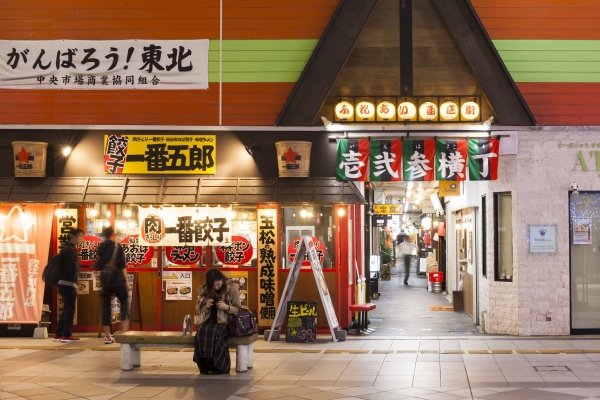
Nostalgia: "a sentimental longing or wistful affection for a period in the past". It’s a feeling that can be associated with anything: food, people, places, and so on. For many people, certain types of place can bring forth an emotional wave of nostalgia, feeling as though they’ve gone back in time. For the locals in Japan, that strong feeling can be invoked by an unremarkable type of place: an alley.
Omoide-Yokocho in Shinjuku. (Image credit: JTA / JNTO)
An alley (横丁 yokochō) is a narrow street in Japan that is often lined with izakaya (居酒屋) and yakitori stalls, and is often associated with people looking for an affordable place to drink and mingle with friends late at night. It’s the perfect type of place for people looking for a fun atmosphere, great (and especially affordable) food, and good sake. Plus, it would be a waste to overlook them especially for those seeking an authentic and uniquely Japanese nightlife experience.
A typical alley in Japan. (Image credit: JNTO)
Seasoned travellers to Japan would vouch for its alleys; they claim that the grittiness and ungentrified nature of the alleys are what makes dining there a genuine and special experience. Alleys are the kind of place that locals would patronise continually, be it salarymen after a long day at work or just friends looking for a pub crawl (はしご 酒 hashigo-zake). Also, in recent times, alleys are somewhat experiencing a renaissance in popularity, as young people (especially those liking hipster places) and foreign visitors are gradually becoming attracted to them.

Tokyo's plentiful alleys. (Image credit: Yasufumi Nishi / JNTO)
The Tohoku Region (東北地方 Tōhoku-chihō) has its own fair share of alleys, some with their own quirks that people ought to check out. For this article, I’m going to introduce to you the alleys of Tohoku, the lesser known gems in the northeastern region that are a little different from your usual tourist attractions. Many visitors flock to Tohoku to experience its natural beauty, great food, and wonderful hot springs. But alleys? That’s something unusual, and what you can find here might surprise you!
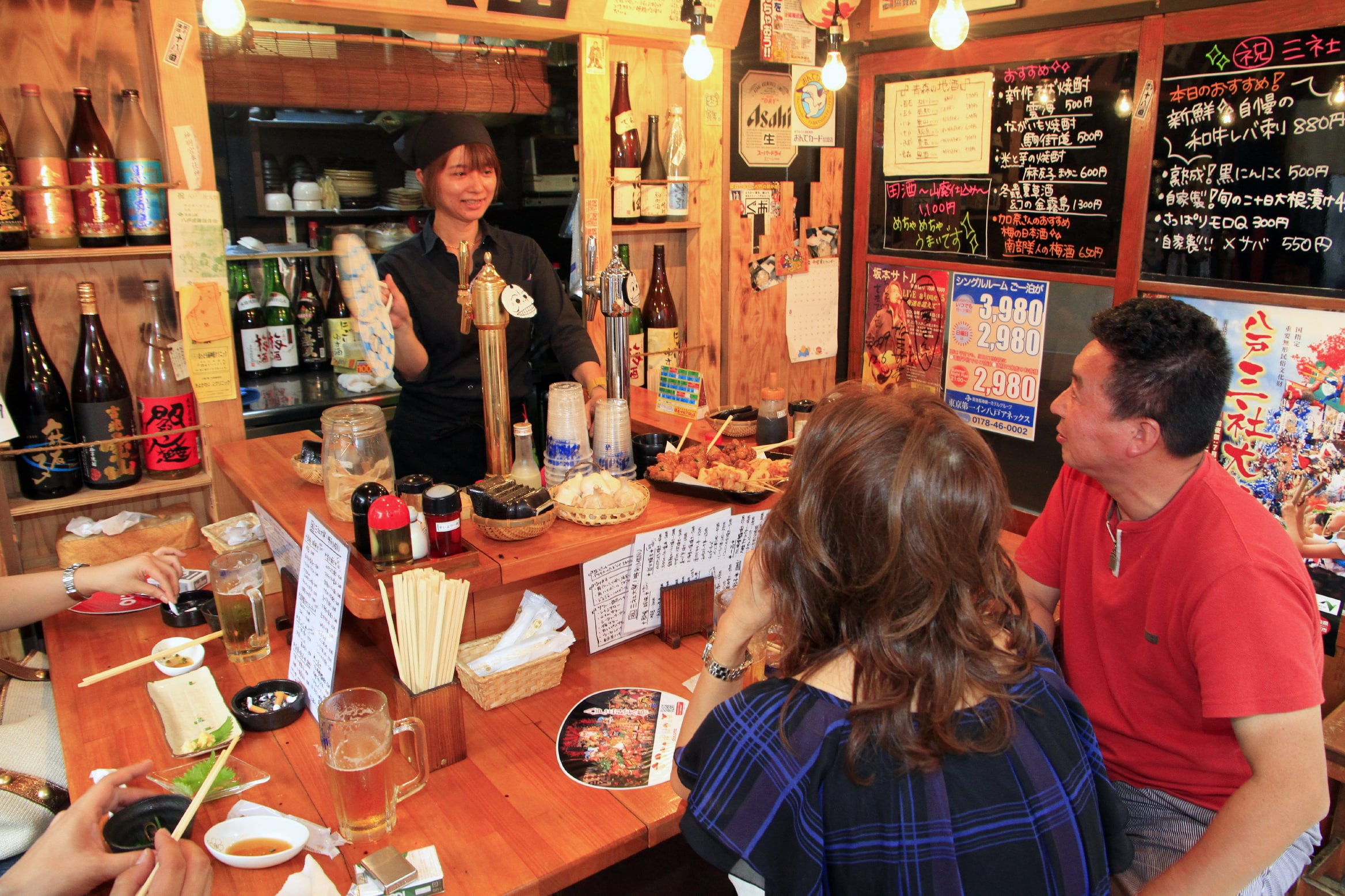
Miroku-Yokocho in Hachinohe, Aomori. (Image credit: Aomori Prefecture)
Miroku-Yokocho (みろく横丁) in Hachinohe, Aomori
Hachinohe (八戸市 Hachinohe-shi) is a quiet city in the south-eastern side of Aomori Prefecture (青森県 Aomori-ken), the northernmost prefecture in Tohoku. As known for the whole of Aomori, Hachinohe is famous for its food, especially when it comes to seafood.
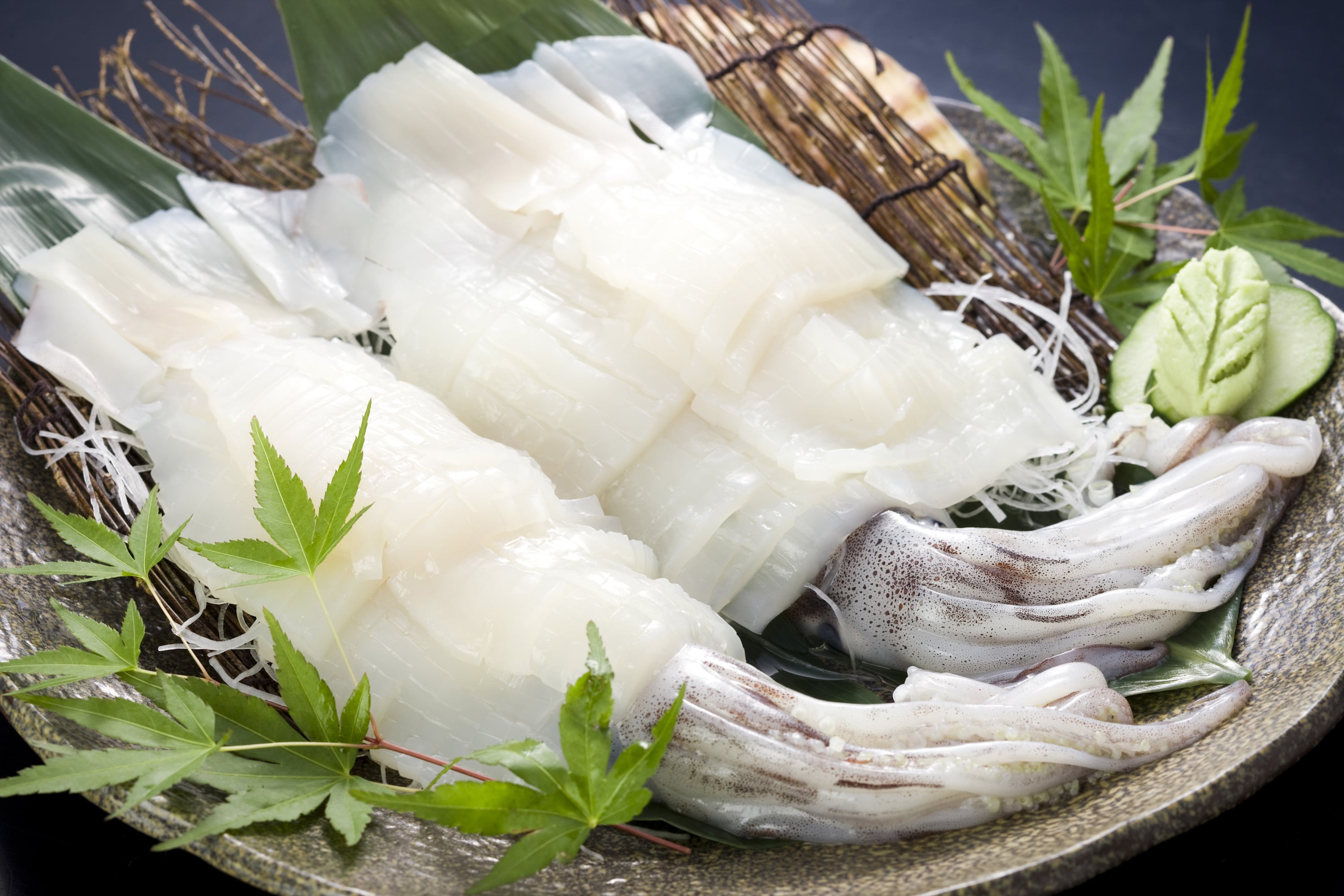
Squid is a main highlight in Hachinohe. (Image credit: Aomori Prefecture)
Hachinohe is a food haven that offers some of Aomori’s best seafood. Sushi is a must for any visitors, but if there’s one particular seafood that deserves attention, it’s their squid (イカ ika). The port of Hachinohe catches the most amount of squid in Japan, and it has a wide variety available: neon flying squid (赤烏賊 aka-ika), Japanese flying squid (鯣烏賊 surume-ika), spear squid (槍烏賊 yari-ika), just to name a few.

Senbei-jiru is a must-try when in Hachinohe. (Image credit: Aomori Prefecture)
When in Hachinohe, eat senbei-jiru (せんべい汁)!
Tohoku Region produces a lot of wheat because of the cold weather, and Aomori specialises in making wheat crackers known as Nanbu-senbei (南部せんべい). And this is how their local specialty senbei-jiru came to be, where Nanbu wheat crackers are added in a hearty soup and best enjoyed during chilly seasons. They can be found everywhere in Hachinohe, including at Miroku-Yokocho, and it’s one of the definitive dishes of the city that’s not to be missed.
Ichigoni. (Image credit: Aomori Prefecture)
Another dish to try in Hachinohe is ichigoni (いちご煮), which is soup made with fresh sea urchin and abalone. Hachinohe is blessed with amazing seafood because of its proximity with the Pacific Ocean, and this dish is a perfect example to showcase its food. Also, the name translates as “strawberry soup”, although it doesn’t have any strawberries in it, because of the bits of sea urchin that float in the milky white broth of the soup. These pieces of sea urchin are said to poetically resemble wild strawberries veiled in the morning dew.
Hachinohe is home to a quirky food stall village named Miroku-Yokocho. The name comes from its location, running through Mikkamachi (三日町, where "Mi" means three) and Muikamachi (六日町, where "Muika" means sixth day). Although it is an alley, it’s unlike the ones most people would imagine.
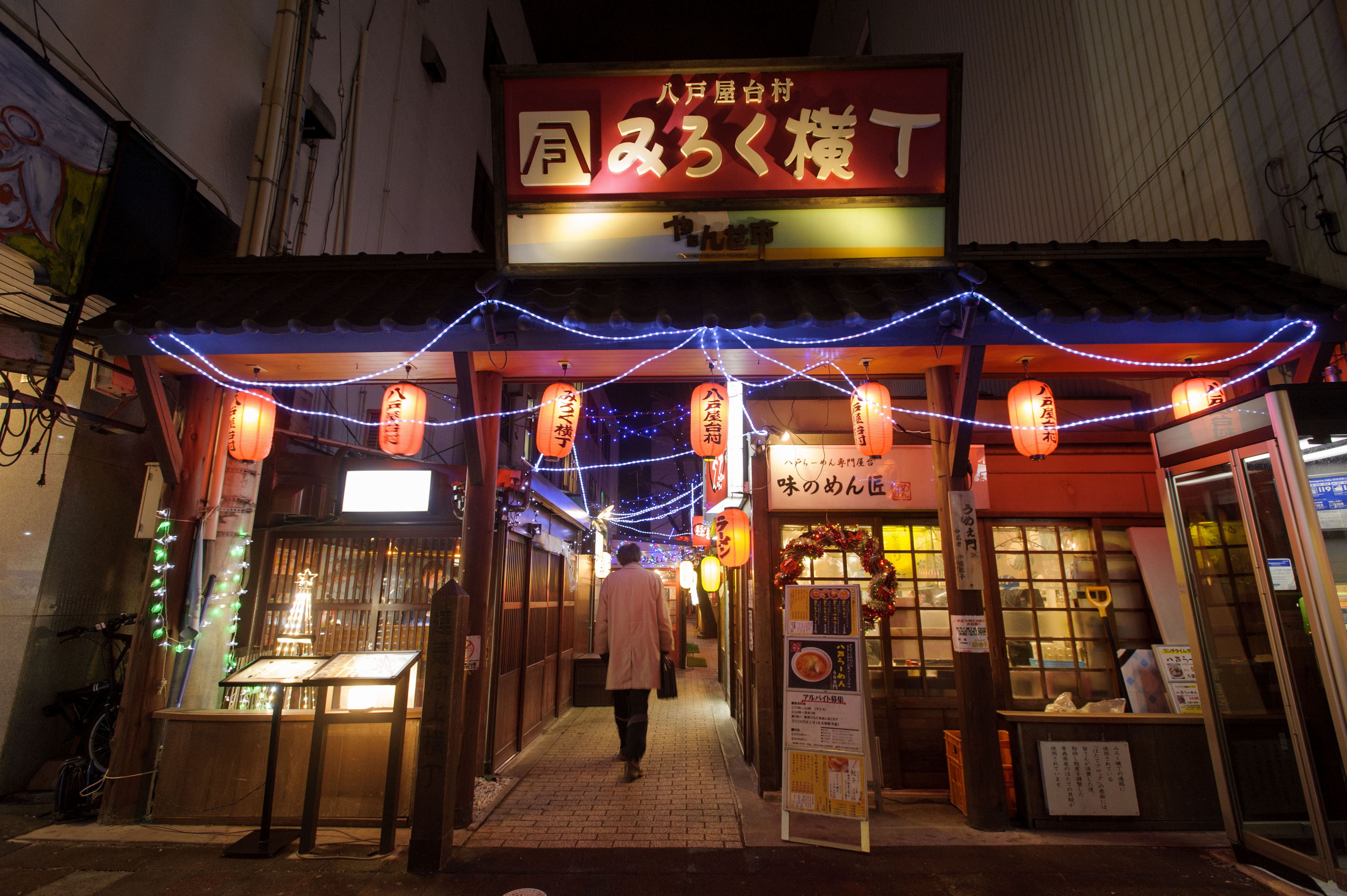
Miroku-Yokocho in Hachinohe. (Image credit: Aomori Prefecture)
Imagine this: 26 brightly decorated stalls in a single lively space, showcasing local Aomori delicacies. That’s what Miroku-Yokocho is about: an enclave for foodies to have a taste of what Hachinohe has to offer under one roof. Each stall features their own specialty menu items using special local ingredients, and they all pair perfectly with a side of alcohol.
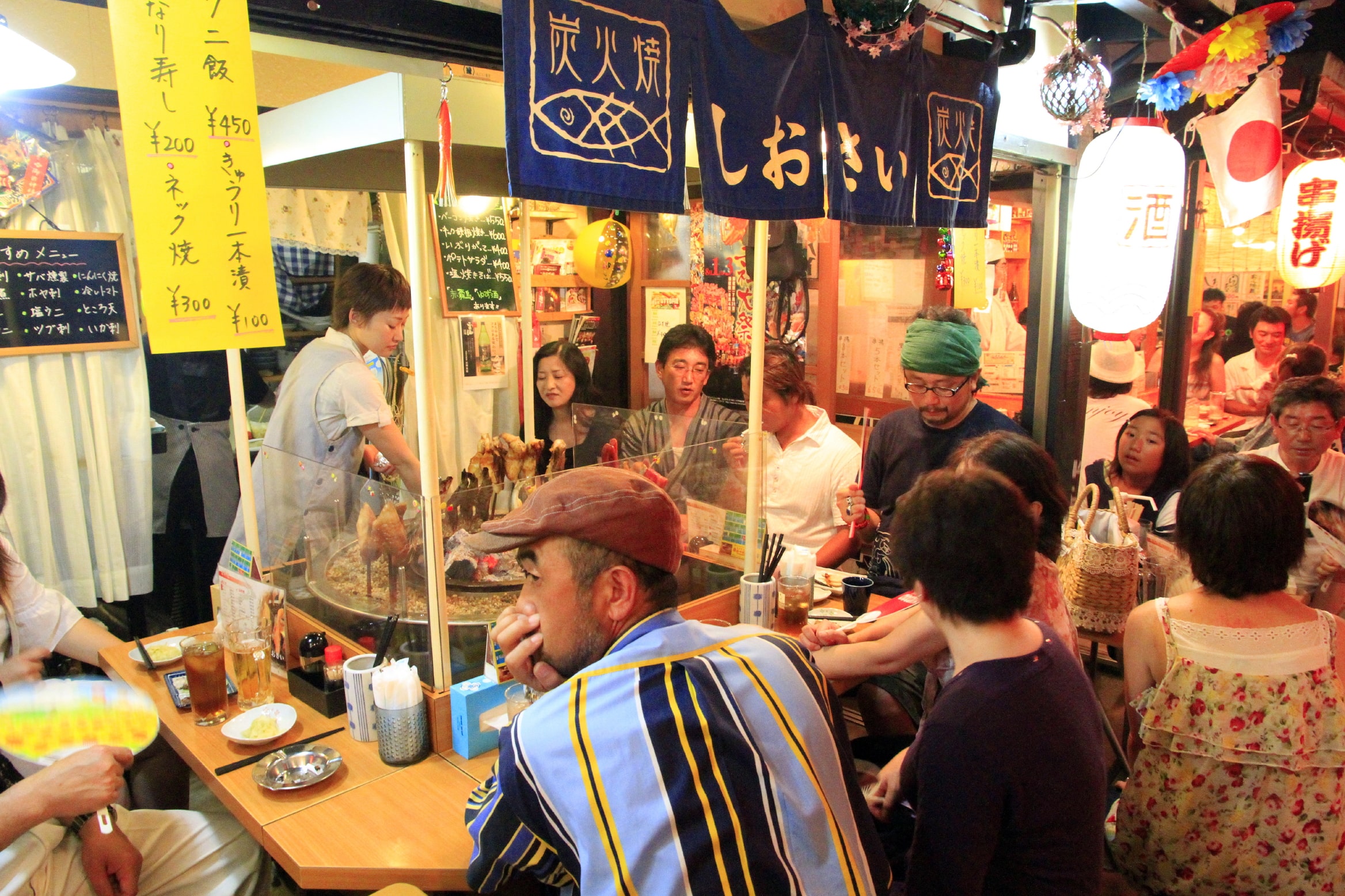
Food stalls in Miroku-Yokocho. (Image credit: Aomori Prefecture)
Like a typically authentic alley, Miroku-Yokocho has a packed and boisterous atmosphere. Although located in a quiet city that is practically empty after 7pm, the alley is crowded in the evenings, even on weekdays! Each food stall is 3.3 square metres in size, and can accommodate only up to 8–10 customers at a time. Plus, the stalls are close to each other, so patrons can easily hop from one stall to another. Imagine that: a food-crawling experience where you can try all of Hachinohe’s local specialties in one night!
Highlights of Miroku-Yokocho
If you want to have a food-crawl but don’t know where to start, then fret not. Here are some highlights of selected shops at the food village to get your food-crawling ideas up and going!

Odaidokoro NENE (お台所ねね). (Image credit: Miroku-Yokocho)
Come here for local cuisines and fresh seafood, and dine in a homely atmosphere. The shopkeeper lady, who is regularly dressed in traditional Japanese clothing, is especially kind and is even known to be a senbei-jiru “meister”!

Umi no Sachi MIMI (海の幸「美味」). (Image credit: Miroku-Yokocho)
MIMI specialises in serving fresh and delicious fish, alongside a wide selection of local sake. The owner of the shop used to be a fisherman.
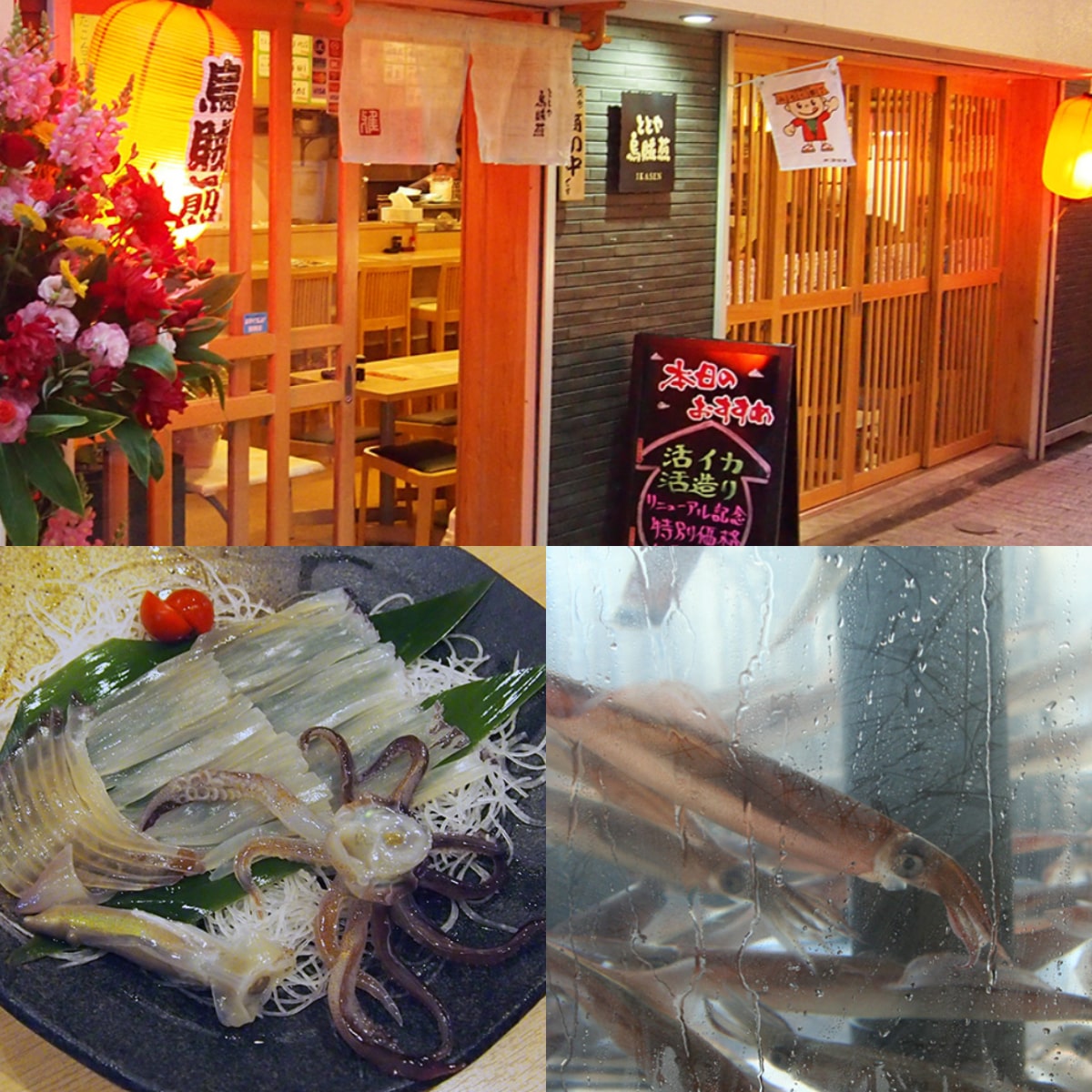
Totoya IKASEN (ととや烏賊煎). (Image credit: Miroku-Yokocho)
This is the place to be if you want to try Hachinohe’s specialty: squids! They’re freshly caught live from their water tank upon order.
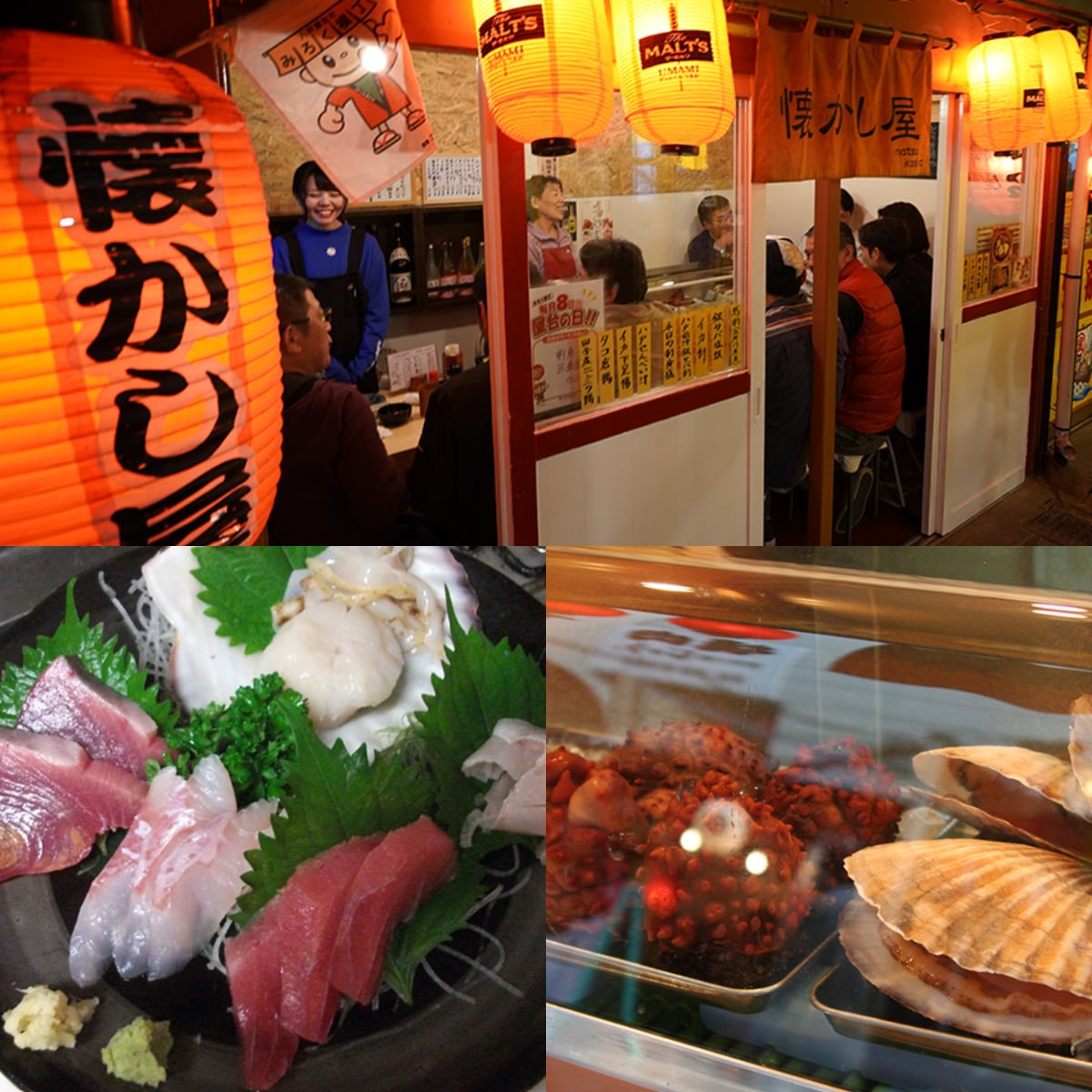
Natsukashiya (懐かし屋). (Image credit: Miroku-Yokocho)
Here’s another shop that specialises in fresh fish straight from the Hachinohe Port. Their house special is the mackerel, best enjoyed grilled or as sashimi.
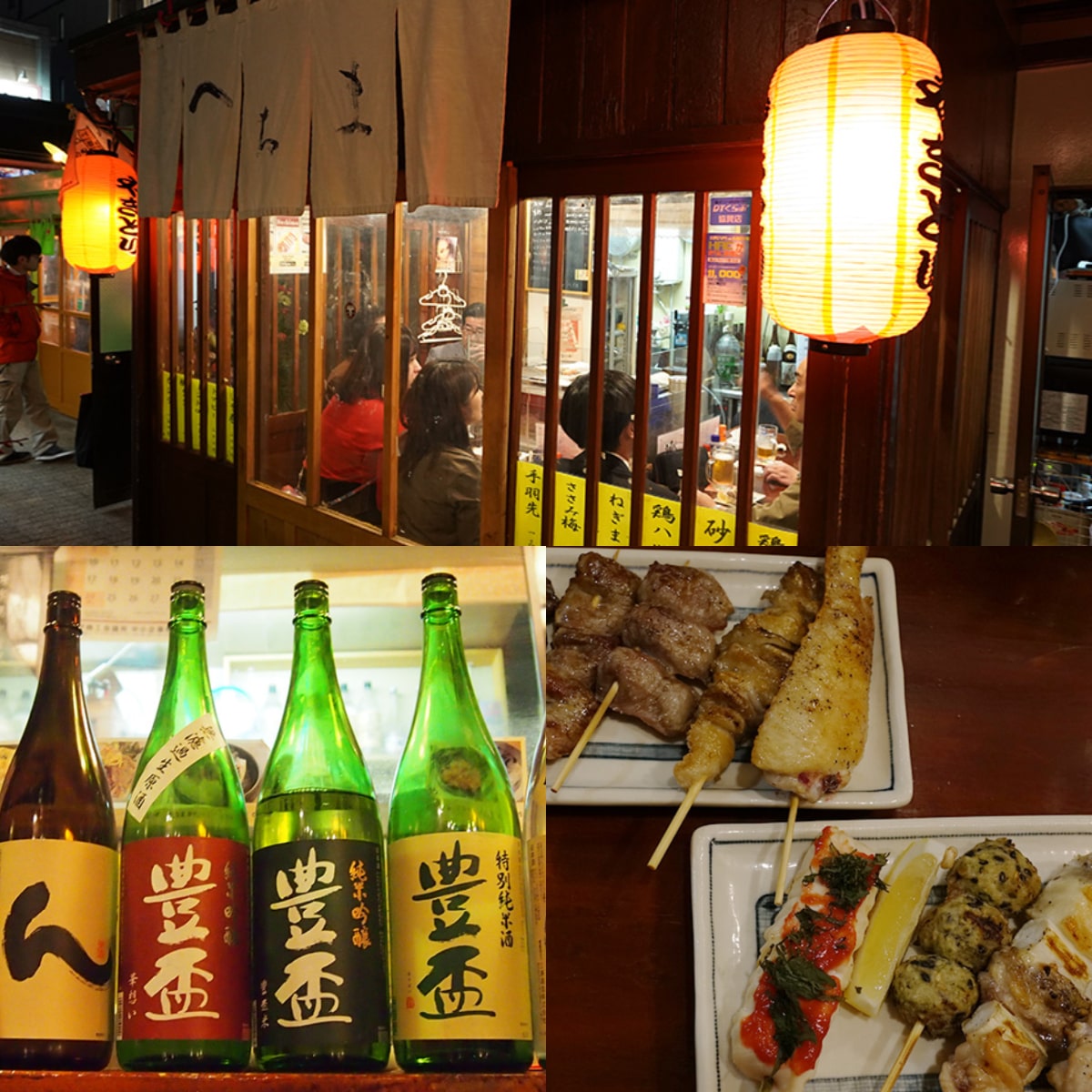
Hechima (へちま). (Image credit: Miroku-Yokocho)
This restaurant is the place to be if you want something other than seafood for a change: grilled meat skewers (焼き鳥 yakitori)! Even better, it serves Towadako wagyu beef and seasonal ingredients such as wild vegetables (spring), sea urchin (summer), mushrooms (autumn), and oysters (winter).
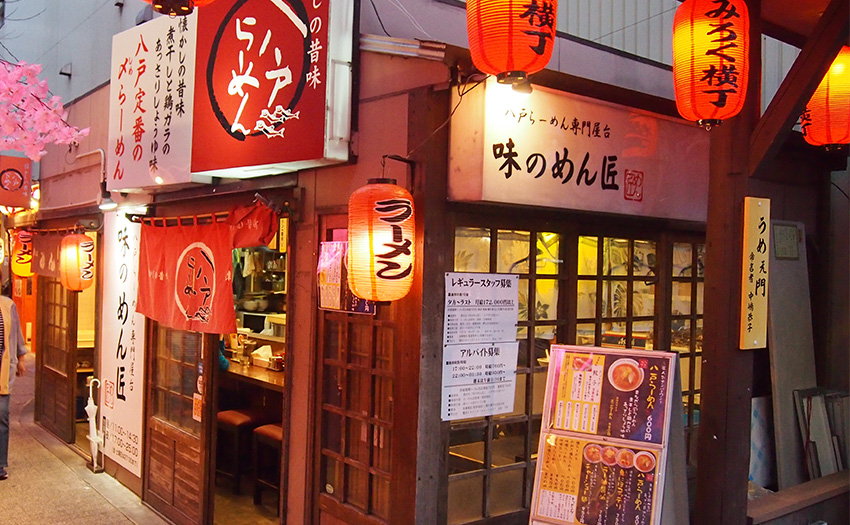
Aji no Mensho. (味のめん匠) (Image credit: Miroku-Yokocho)

Menu at Aji no Menshō. (Image credit: Miroku-Yokocho)
What better way to end a night of delicious sake than with (Hachinohe) ramen! Hachinohe ramen is a specialty of the city: shoyu ramen made with chicken and dried sardines. A perfect dish to end the night (and a good way to prevent hangovers)!
Miroku-Yokocho (みろく横丁)
Address: Between Mikkamachi and Muikamachi, Hachinohe City, Aomori Prefecture
Nearest station: JR Hon-Hachinohe Station (JR本八戸駅)
Opening hours: Varies according to shop, usually until late hours
Admission fee: none
Tel: +81-178-29-0815
Iroha-Yokocho (いろは横丁) & Bunka-Yokocho (文化横丁) at Sendai, Miyagi
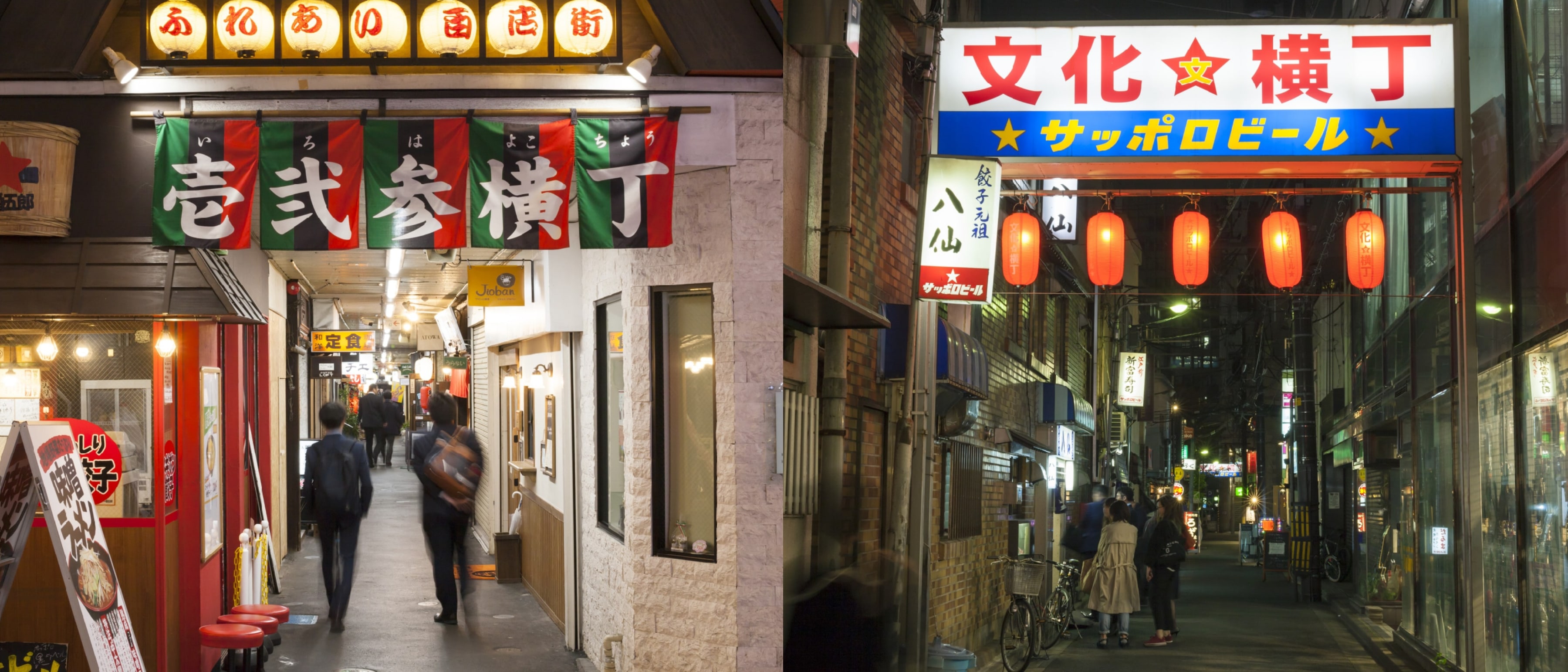
Iroha-Yokocho and Bunka-Yokocho in Sendai. (Image credit: 仙台観光国際協会)
When it comes to travelling in Tohoku, most people would almost visit or at least pass by Miyagi Prefecture (宮城県 Miyagi-ken) at some point, for its centrality serves as a starting point for travelling around the northeastern region. And of course, people will make some time to explore the capital city Sendai (仙台市 Sendai-shi). But if you ask fans of the city to name some hidden gems, a few might quote the unassuming alleys right in the heart of the city.
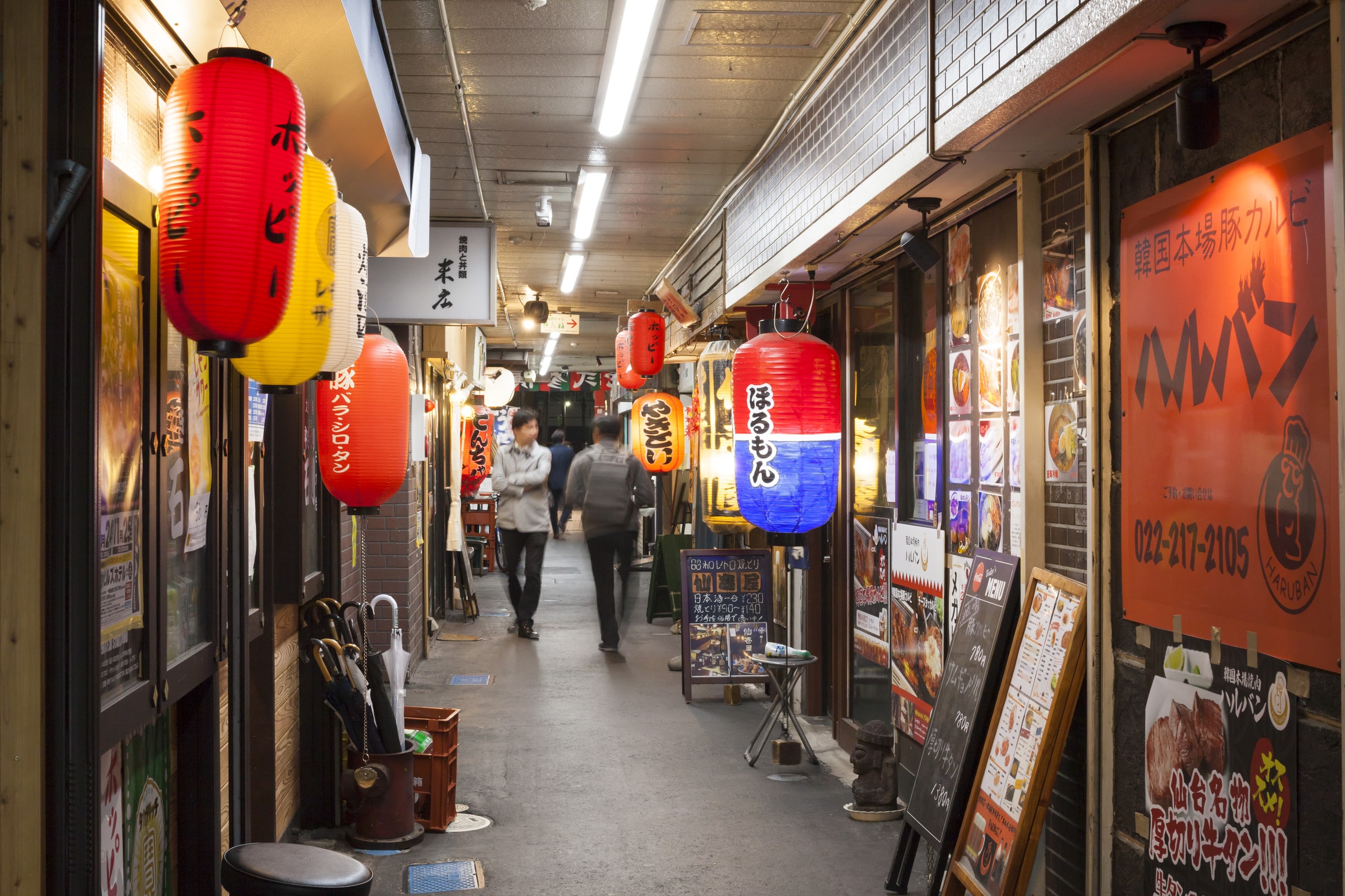
Iroha-Yokocho in the heart of Sendai. (Image credit: 仙台観光国際協会)

Inside Toriyoshi, a yakitori restaurant inside Iroha-Yokocho. (Image credit: In-outbound sendai-matsushima inc.)
Iroha-Yokocho is a quirky alley located right in the heart of Sendai, and many foreign visitors try to pay a visit here at least once when in the city. It has roots stretching back to post-World War 2, and to this day it still retains the nostalgic ambience of the Showa Era (昭和時代 Shōwa-jidai, dating 1926–1989).
Retro interiors inside eateries at Iroha-Yokocho. (Image credit: JR Times / Sue Lynn)
Iroha-Yokocho is made up of an eclectic mix of more than 100 shops. Not only are there plenty of izakaya, Japanese and Western-style restaurants, but also shops selling leather goods, a cigar store, an antique shop, a classic bookstore, and (check this out) a fortune teller! Not only is this alley a great place for drinking and dining, but it also even screams hipster!

Food fare in an izakaya in an alley. (Image credit: In-outbound sendai-matsushima inc.)
When it comes to the food, patrons will be spoiled for choice over the many food joints available at Iroha-Yokocho. For first-time visitors unacquainted with the usual food fare in an alley, it offers the usual default choices: ramen (probably the most popular go-to meal after a drinking session to prevent hangovers), food skewers (焼き鳥 yakitori) that is almost always ordered alongside your booze of choice, and oden (おでん), a timeless classic for a late-night dish to ease your hunger pangs.
Alleys are a good place for authentically Japanese experiences. (Image credit: JR East / Kobori)
Iroha-Yokocho at night. (Image credit: 仙台観光国際協会)
Best of all, Iroha-Yokocho is in the metropolitan area of Sendai, and just a few blocks away from JR Sendai Station (JR仙台駅 Sendai-eki). With a central location, the alley is a favourite for hangout spot for people working in that area or simply anyone in the city. It’s different from your usual gloomy ones lined with hole-in-a-wall shops; this one’s worth a peek for all visitors! Iroha-Yokocho isn’t the only alley that visitors can check out while in Sendai.
Right around the corner of Iroha-Yokocho is yet another alley named Bunka-Yokocho, and it boasts its own charms and appeal. Translated as "culture alley", it is an unassuming street with plenty of cultural and even historical significance.
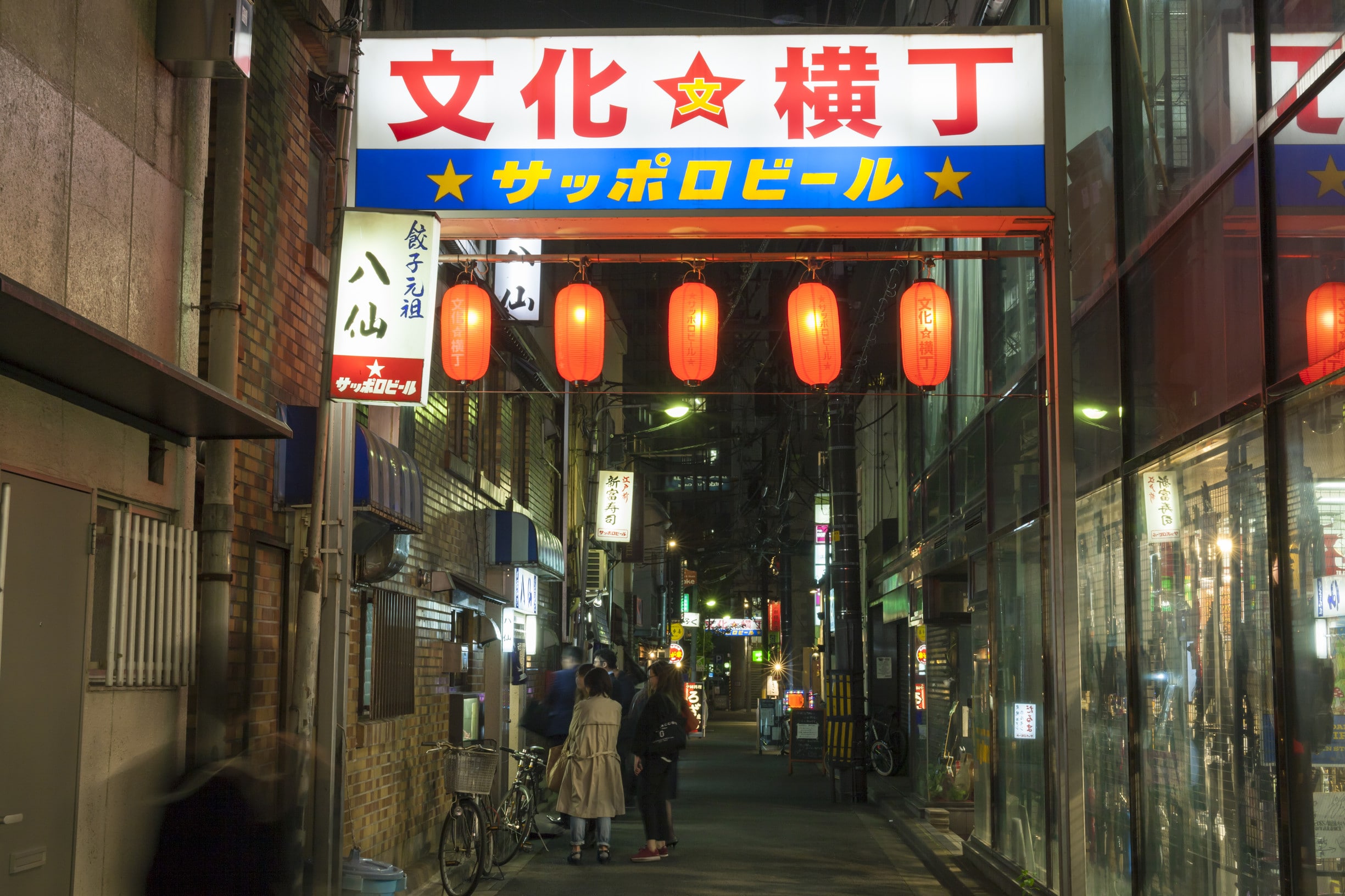
Bunka-Yokocho in Sendai. (Image credit: 仙台観光国際協会)
Bunka-Yokocho is located in the same block as Iroha-Yokocho, so it’s easy to hop from one alley to another. It’s along Aoba-dori (青葉通り), the main avenue of the Sendai that is directly connected to JR Sendai Station, so getting there is a cinch. Despite its central location, the alley is not as crowded as one might think, so it’s conducive for those who want to enjoy a pleasant evening without the boisterous crowd.
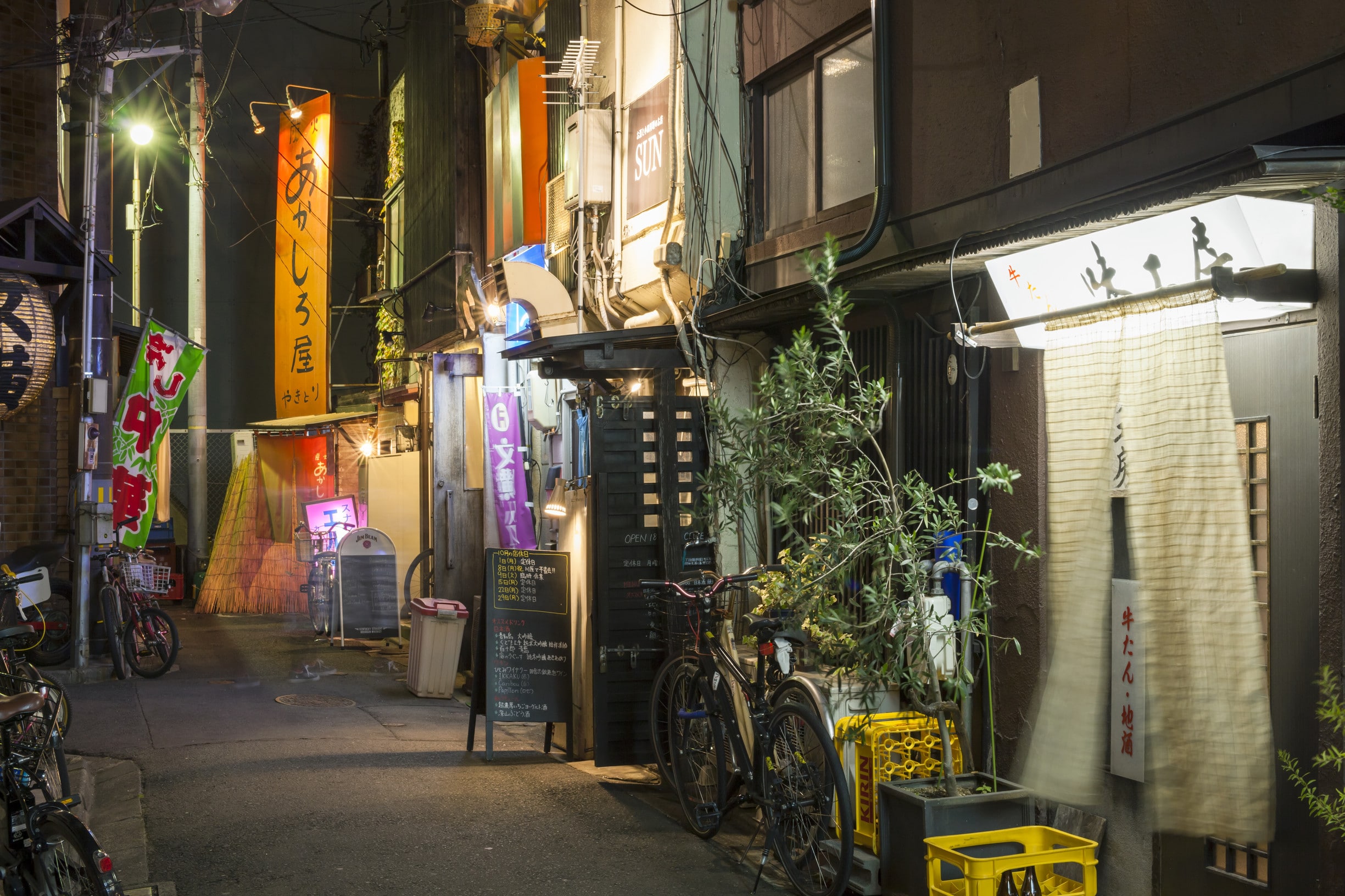
Bunka-Yokocho is just next door to Iroha-Yokocho. (Image credit: 仙台観光国際協会)
Bunka-Yokocho is also a tad different from Iroha-Yokocho in terms of theme and ambience. Most of the longest running shops are located in Bunka Yokocho, and it’s highly recommended for visitors who want to have a feel the history of the area, or for those looking for a slow and enjoyable evening for dinner and drinks. Iroha-Yokocho however, has a lot of food and drinks but also an eclectic mix of shops—a general store, clothes shop, tea store, butcher shop—so the overall ambience is different.
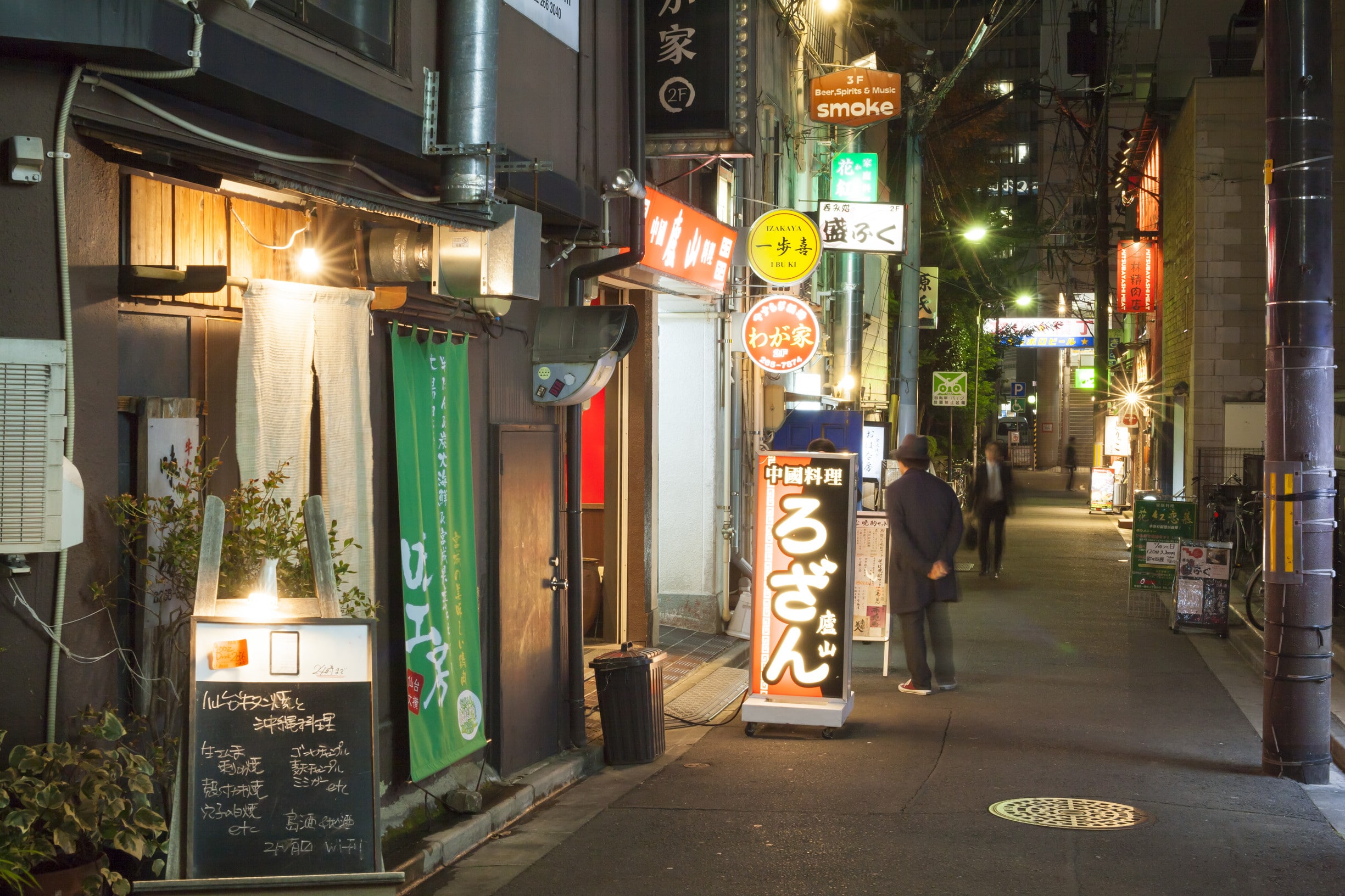
Bunka-Yokocho at night. (Image credit: 仙台観光国際協会)
What makes Bunka-Yokocho and Iroha-Yokocho intriguing is the difference in atmosphere between day and night. Iroha-Yokocho is better for visitors looking for something more casual whereas Bunka-Yokocho is more suited for those looking for something classier. Nevertheless, you can feel the various eras of Japan for both places, so it feels like a miniature version of the country.
Highlights of Iroha-Yokocho
Aching to start your food and pub-crawling adventures? Here are highlights of selected shops at Iroha-Yokocho!
① Toriyoshi (鳥よし)

Toriyoshi (鳥よし). (Image credit: JR East / Kobori)
This restaurant serves great yakitori using fresh meats, and they are specially prepared only upon order. Reservations are highly encouraged, as the place can accommodate 6–8 people at a time.
② Nidaime (二代目)

Nidaime (二代目). (Image credit: JR East / Kobori)
This is a modest and homely eatery serving local cuisines and sake from Miyagi Prefecture. For the more adventurous patrons, try the basashi (馬刺し), which is horse sashimi, and torisashi (鳥刺し), which is chicken strips where only the outside is seared, leaving the inside still pink.
③ Kakigoya ROKKO (牡蠣小屋ロッコ)

Kakigoya ROKKO (牡蠣小屋ロッコ). (Image credit: JR East / Kobori)
ROKKO is a "eating while standing" (立ち食い・立ち飲み) type of eatery that specialises in oysters, a specialty of Miyagi Prefecture. Each oyster here is only ¥100, which is a steal!
Highlights at Bunka-Yokocho
For a fancier night at Bunka-Yokocho, try out these selected restaurants just around the corner!
① Genji (源氏)
Genji (源氏). (Image credit: JR East / Kobori)
This retro establishment has been around for more than 70 years, and visitors will feel like they’ve been transported back in time once inside. Sake lovers must not miss this place!
② Shu Shu (酒趣)

Shu Shu (酒趣). (Image credit: JR East / Kobori)
The restaurant serves French cuisine with sake! The owner loves sake, and is meticulous in ensuring that his cuisine pairs perfectly with sake. Its wide range of sake is sourced from all over Japan, and they are carefully chosen to pair with each French delicacy so that patrons will have an unforgettable fusion dining experience.
③ Hassen (八仙)

Hassen (八仙). (Image credit: JR East / Kobori)
This establishment serves Chinese cuisine, and the dumplings are to die for! Be warned: Hassen is very popular among the locals, and bee lines are formed each day so be prepared to wait during meal hours.
(Note: the recommended establishments are highly popular (read: it gets crowded easily), so it’s best to show up right after they open for business!)
BONUS: Recommended courses for Iroha-Yokocho / Bunka-Yokocho!
Need some inspiration on what to have at the two alleys? Here are some ideas to kick off your food / pub-crawling adventures!
Course A: Yakitori – Gyoza Course (OPTIONAL: Ramen!)
This is the default pub-crawling course for any alley in Japan!
① Toriyoshi (Iroha-Yokocho) → ② Hassen (Bunka-Yokocho) → ③ Ramen @ *Dashiro (だし廊)
*This ramen joint is located less than 100 metres away from Iroha-Yokocho, and serves wonderful ramen using local ingredients. It also has a second store a few blocks away that sells halal ramen, and I mentioned in another article so have a look at it too!
Course B: Izakaya – Gyoza Course (OPTIONAL: Ramen!)
This course is great for anyone who is too spoiled for choice, as the following eateries have a wide choice for their menus! Note: Nidaime and Genji are highly popular, so we recommend you arrive at the restaurant just as they start opening for business.
① Nidaime (Iroha-Yokocho) or Genji (Bunka-Yokocho) → ② Hassen (Bunka-Yokocho) → ③ Ramen @ Dashiro
Course C: Oysters – Nihonshū – Gyoza Course
This course is great for nihonshū lovers, with a local specialty on the side. In particular, oysters as starters and ending off the crawl with a classic Japanese dish.
① Kakigoya ROKKO (Iroha-Yokocho) → Natsukashiya (Iroha-Yokocho) / Shu Shu (Bunka-Yokocho) → Gyoza @ Hassen (Bunka-Yokocho)
Iroha-Yokocho (いろは横丁)
Address: 2-3-28, Ichiban Street, Aoba Ward, Sendai City, Miyagi Prefecture
Nearest station: JR Sendai Station (JR仙台駅)
Opening hours: Varies according to shop, usually until late hours
Admission fee: none
Tel: +81-22-223-3151
Fax: +81-22-223-3152
Bunka-Yokocho (文化横丁)
Address: 2-4-16 Ichiban Street, Aoba Ward, Sendai, Miyagi Prefecture
Nearest station: JR Sendai Station (JR仙台駅)
Opening hours: Varies according to shop, usually until late hours
Admission fee: none
People often seek out the usual tourist attractions when visiting Japan, and as a result, most miss out on inconspicuous alleys that provide patrons with an authentically Japanese dining and drinking experience. Alleys are remnants of the country’s bygone days, and people often feel like they travel back in time whenever they set foot inside the narrow pavements and make their way to their favourite shops. Why not seek out these lesser-known gems and treat yourself to an unforgettable experience?
More details on the alleys
Miroku-Yokocho: the alley is located in the city of Hachinohe in Aomori Prefecture, between Mikkamachi and Muikamachi. It is open throughout the year except during the winter season, and operating hours vary according to each stall.
Visitors can take the Tohoku Shinkansen (東北新幹線) from JR Tokyo Station (JR東京駅 Tokyo-eki), JR Sendai Station (JR仙台駅 Sendai-eki), or JR Morioka Station (JR盛岡駅 Morioka-eki) to JR Hachinohe Station (JR八戸駅 Hachinohe-eki). From JR Hachinohe Station, switch to the JR Hachinohe Line (JR八戸線 Hachinohe-sen) and alight at JR Hon-Hachinohe Station (本八戸駅 Hon-Hachinohe-eki). It’s a 10-minute walk southward to Miroku-Yokocho.
The train journey to Hon-Hachinohe takes 3 hours 15 minutes and costs ¥16,590 per adult (from Tokyo), 1 hour 45 minutes and costs ¥9,440 (from Sendai), or almost 1 hour and costs ¥4,380 (from Morioka).
Iroha-Yokocho / Bunka-Yokocho: the alleys are located in the city of Sendai in Miyagi Prefecture, and they are open throughout the year. Operating hours vary according to each shop.
Visitors from Tokyo can take the Tohoku Shinkansen from JR Tokyo Station to reach JR Sendai Station. Iroha-Yokocho is located almost 1km west of JR Sendai Station, and visitors can get there on foot in 10–15 minutes. The train journey from Tokyo to Sendai takes approximately 90 minutes, and the fare is ¥11,090 with seat reservation.
(INSIDER TIP: If you have the JR EAST PASS (Tohoku area), you can travel on the Tohoku Shinkansen and make seat reservations for free!)
JR EAST PASS (Tohoku area)
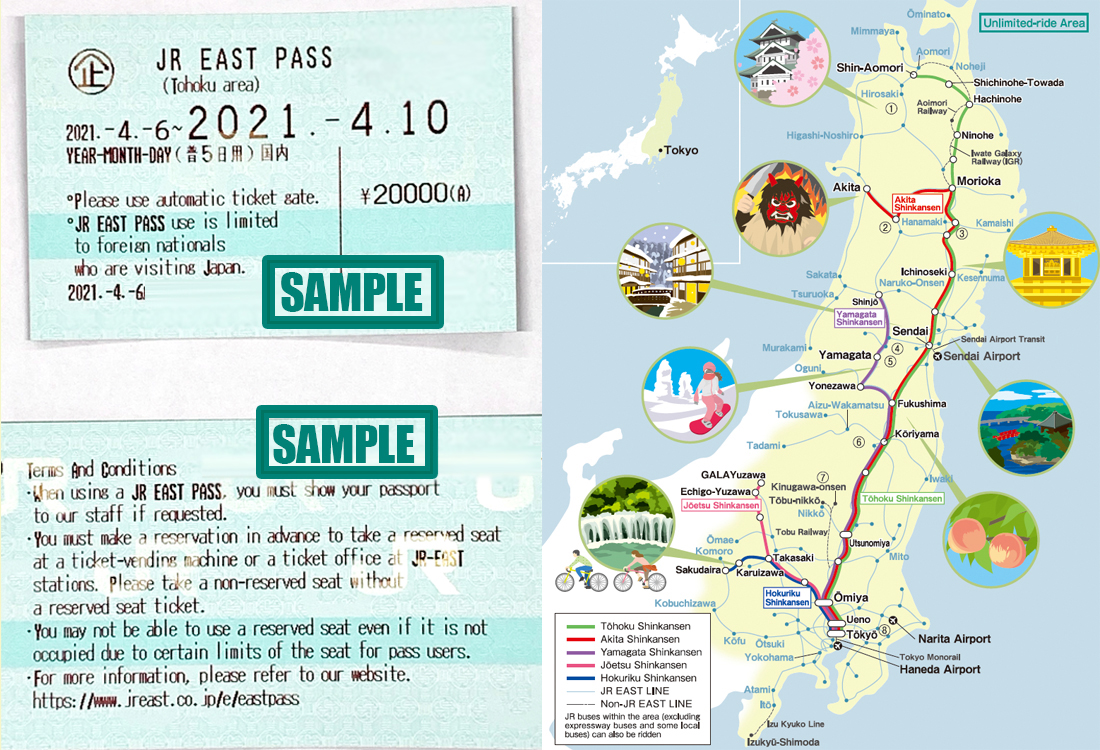 The new JR EAST PASS (Tohoku area) and where you can use it. (Image credit: JR East)
The new JR EAST PASS (Tohoku area) and where you can use it. (Image credit: JR East)
The JR EAST PASS (Tohoku area) is an affordable pass that offers unlimited train rides on JR East lines, including bullet trains, within the valid area for 5 consecutive days. It's only ¥20,000, making it a considerable chocie for rail travellers. Pass holders can also reserve seats online for up to a month in advance for free. For more information on the JR EAST PASS (Tohoku area), you can visit the link here.
NOTE: From 1 April 2021, there have been some changes in the validity and pricing of the JR EAST PASS (Tohoku area). For more information, please check here.
Header image credit: Sendai Tourism, Convention and International Association



